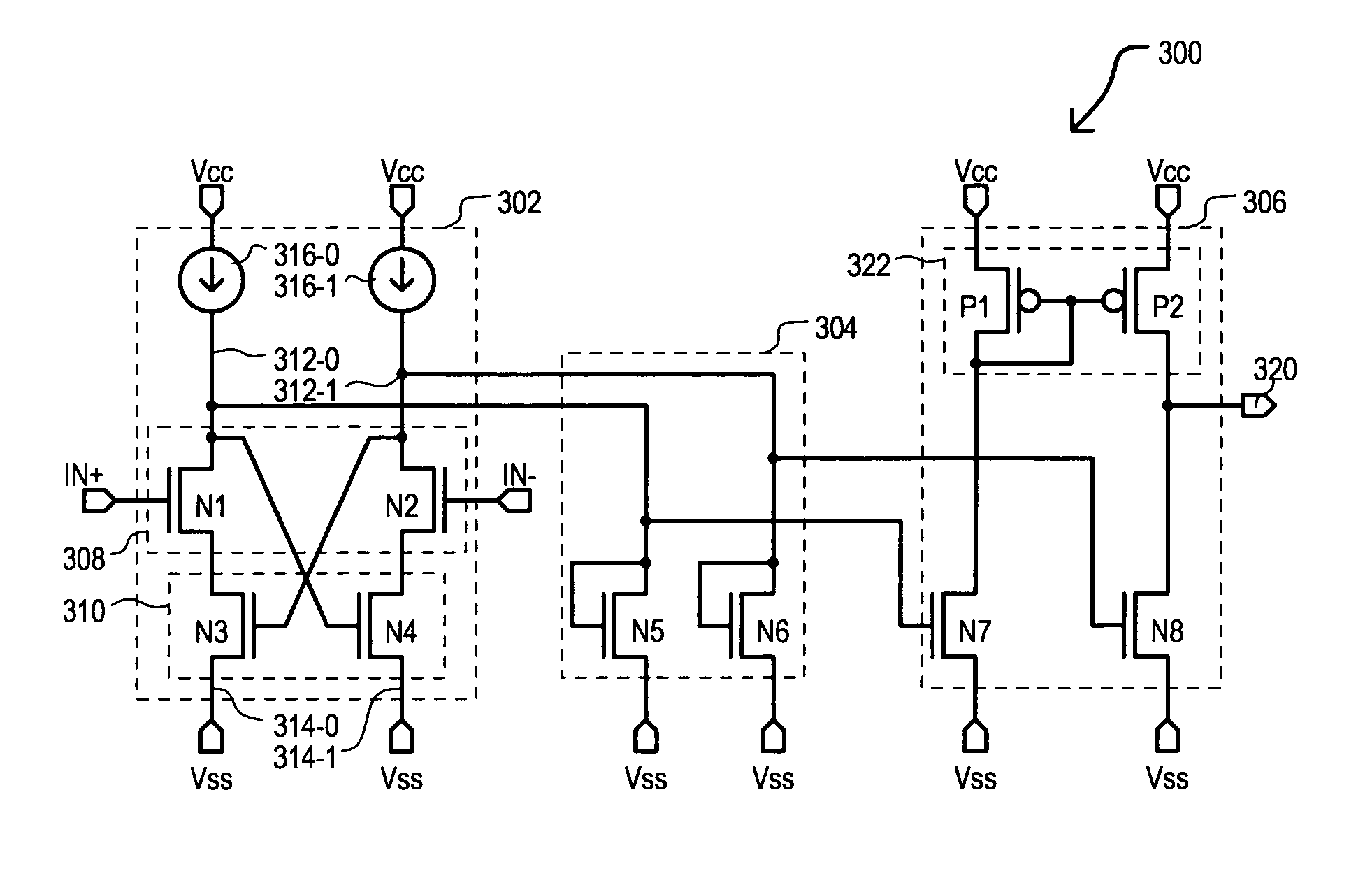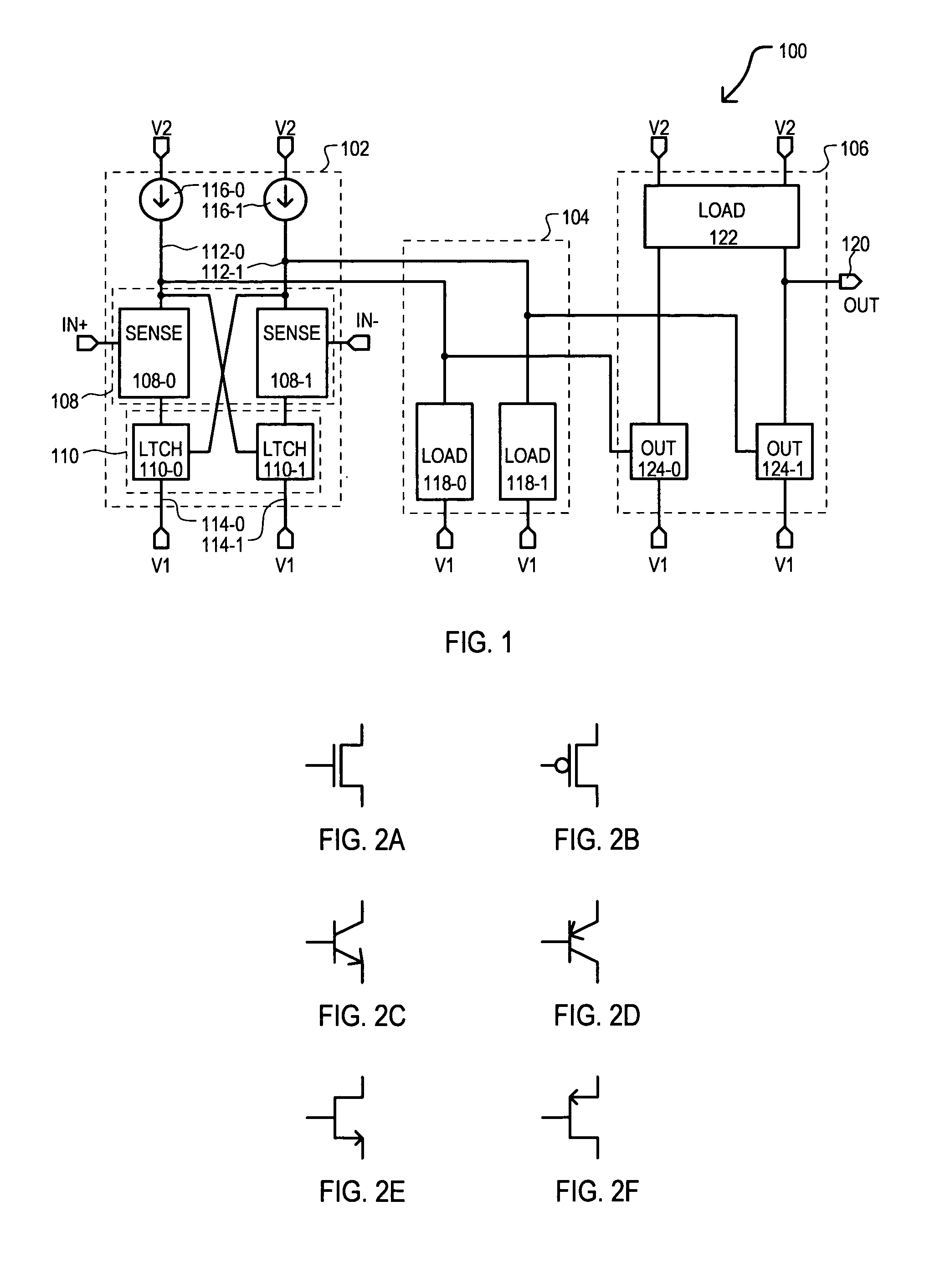Differential-to-single ended signal converter circuit and method
- Summary
- Abstract
- Description
- Claims
- Application Information
AI Technical Summary
Problems solved by technology
Method used
Image
Examples
first embodiment
[0026]A differential to single ended conversion circuit is shown in block schematic diagram in FIG. 1, and designated by the general reference character 100. A circuit 100 can receive an input that includes a first differential input signal IN+ and a second differential input signal IN−, and can provide a single ended output signal OUT.
[0027]A circuit 100 can include an input section 102, a load section 104, and an output section 106. An input section 102 can latch opposite states based on differential input signals.
[0028]In the particular example of FIG. 1, an input section 102 can include a differential sense section 108 and a latching section 110. A differential sense section 108 can include a first sense device 108-0 and a second sense device 108-1. Sense devices (108-0 and 108-1) can be active device, such as transistors, that can provide a controllable impedance path (e.g., source-drain, collector-emitter) according to a control terminal (e.g., gate or base). Sense device 108...
second embodiment
[0041]Referring now to FIG. 3, a latched differential-to-single ended signal converter circuit is shown in schematic diagram, and designated by the general reference character 300. A circuit 300 can include some of the same general sections as FIG. 1, thus like sections are referred to by the same reference character, but with the first digit being a “3” instead of a “1”.
[0042]FIG. 3 shows an arrangement in that can receive a potentially problematic latched differential signal (differential signals whose crossing point is very close to a maximum signal voltage) and convert it into a single-ended full swing logic signal with nearly the same duty cycle as the differential signal. That is, when latched differential signals having crossing points with essentially 50% duty cycles, a circuit 300 can provide a resulting output signal with a corresponding 50% duty cycle.
[0043]The circuit 300FIG. 3 shows an example of a “NAND” type arrangement. An input section 302 can include a differentia...
fifth embodiment
[0060]Referring now to FIG. 6, a phase locked loop (PLL) circuit is shown in a block schematic diagram and designated by the general reference character 600. A PLL 600 can include a phase detector 602, a filter section 604, a voltage controlled oscillator (VCO) 606, an output stage 608, and a feedback path 610. A phase detector 602 can receive an input signal Sin and a feedback signal Sfdbk, and determine a phase difference between such values ph_diff. A phase difference value ph_diff can be filtered by a filter section to generate a control voltage Ve. A VCO 606 can be a ring oscillator that generates a differential signal IN+ / IN− whose output frequency can vary according to control voltage Ve. As but one example, a VCO can be a ring oscillator signal like that shown as 500 in FIG. 5.
[0061]Referring still to FIG. 6, output stage 608 can receive differential input signals IN+ / IN−, and in response thereto, generate a single ended output signal Sout. An output stage 608, like that sh...
PUM
 Login to View More
Login to View More Abstract
Description
Claims
Application Information
 Login to View More
Login to View More - R&D
- Intellectual Property
- Life Sciences
- Materials
- Tech Scout
- Unparalleled Data Quality
- Higher Quality Content
- 60% Fewer Hallucinations
Browse by: Latest US Patents, China's latest patents, Technical Efficacy Thesaurus, Application Domain, Technology Topic, Popular Technical Reports.
© 2025 PatSnap. All rights reserved.Legal|Privacy policy|Modern Slavery Act Transparency Statement|Sitemap|About US| Contact US: help@patsnap.com



